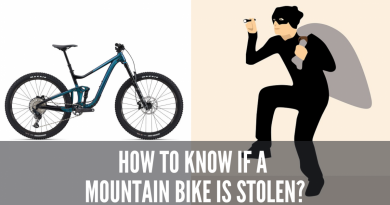Is Mountain Biking an Extreme Sport? (5 Facts)
Is Mountain Biking an Extreme Sport?
While mountain biking is an extreme sport. Mountain biking is a very broad term for different disciplines that involve riding bikes on a mountain. The lycra-clad cross-country aspect of the sport might not be considered “extreme,” but there are certainly at least a few aspects of the sport that definitely fall under the extreme umbrella. Extreme sports are defined as those that are dangerous and exciting. The following disciplines in mountain biking fit this description as extreme sports:
Freeride
Freeride is a form of mountain biking that includes a number of different aspects that could be considered extreme. It combines dirt jumping and downhill and places emphasis on tricks and style as well as riding technical trail features. Probably the most well-known and extreme event on the freeride calendar is the Red Bull Rampage event, where a select group of riders build features in Utah and pick the best lines to ride.
Dirt jumping and slopestyle
Dirt jumping and slopestyle can be considered types of freeriding. Slopestyle involves riders riding down a set course, performing tricks on the jumps and drops. Dirt jumping is probably the furthest away from what people would consider to be mountain biking and involves hitting man-made jumps.
Enduro
Probably is the fastest growing discipline in mountain biking. It combines elements of cross country with features of downhill. The downhill parts of the sport are the most in keeping with the idea of it being an extreme sport, but the enduro races themselves are pretty extreme as the participants only get one practice run before taking part in a very intense competition.
Downhill
Downhill is probably what most people think of when they think of mountain biking and is undoubtedly considered to be extreme. It involves going as fast as you are comfortable with (or faster in some cases!), and the tracks can be steep with features such as jumps, drops, and road gaps. There can also be rocky sections and sections with a lot of routes. The risk and intensity add up to ensure its status as an extreme sport.

Is Mountain Biking a Dangerous Sport?
All sports contain some element of danger, and mountain biking seems like a hazardous sport. However, statistically, it is not actually as dangerous as people might initially assume.
Studies have shown that mountain biking has an injury rate of 1.54 per 1000 exposures.
In comparison:
BMXing, which stands at 0.8 injuries per 1000 exposures.
Road biking has 3.01 injuries per 1000 exposures.
Other non-cycling sports are even more dangerous.
Soccer has 7.7 injuries per 1000 exposures.
Basketball has 11.1 injuries per 1000 exposures.
Rugby has 13 injuries per 1000 exposures.
Baseball has 14.5 injuries per 1000 exposures.
However, while these numbers are not as cut and dry as they might seem, another source claims that cycling (not necessarily just mountain biking) is the leading cause of sports-related injuries in the USA. Also, these numbers do not consider the severity of the injuries sustained, which can be much more severe in mountain biking.
Can you Die From Mountain Biking?
People can die from far less high-impact activities than mountain biking, so of course, it is possible to die from mountain biking.
One statistic claims that there are, on average, about 1000 cycling-related deaths in the USA every year. With the majority of these coming from road cycling, you can see the stats here.
Most of these are caused by head injuries – an excellent reason to remember to wear a helmet!
The nature of mountain biking also leads to other risks as well – in some countries, including the USA – there have been reported deaths from bear attacks.
However, it could be argued that mountain biking can actually save lives as it offers a perfect cardio workout. There are also the benefits to mental health as well as other health benefits that are harder to quantify.
Also, see Mountain Bike Statistics (30 Interesting Facts & Numbers)
Is Mountain Biking Hard?
Mountain biking can seem challenging when first starting, but it is possible to ease into it and avoid feeling overwhelmed when just starting out. However, there are some things that can add to the difficulty.
It is very physically demanding, and a good level of physical fitness will help people who are just trying it out. The less fit you are, the more tired you will become and the harder you will find it.
The terrain has a great deal to do with the difficulty of riding. Steeper and more bumpy terrain is always harder to ride.
The bike you use will affect the difficulty as well. A hardtail bike will be harder to ride on rougher terrain than a full-suspension mountain bike. However, like any sport mountain biking does have a little learning curve, but mountain biking does have many benefits
How do You Not Get Hurt Mountain Biking?
Preparation is key to avoiding getting hurt when mountain biking. This can be broken down into several things to do before and during your ride.
Check your equipment. Ensure that every part of your equipment is working as it should be. With your bike, check that everything is tight and that the brakes and gears are working. Also, check your helmet and your pads are correctly attached.
Warm-up. It might be tempting to hop on your bike and set off. However, stretching beforehand will help prevent any muscle injuries.
Wear protection. A cycle helmet is an absolute minimum that you should wear when you go out riding. It is also worth considering knee pads, elbow pads, shin pads, and maybe even body armour. Neck braces have become increasingly popular in the past few years as well.
Check what you are about to ride. If you are new to a particular trail or feature, then it’s a good idea to check it out first to avoid any nasty – and potentially dangerous – surprises. Even if you are familiar with what you are about to hit, it’s worth being cautious about sections that might have blind spots.
Stay hydrated. Staying suitably hydrated can prevent feeling worn out, and can lead to accidents.
Is it Safe to Mountain Bike Alone?
Depending on where you are and how well prepared you are, it can be dangerous to mountain bike alone. If you are on a less well-known or well-used trail, it could be hours before anyone comes upon you if something goes wrong. However, there are ways to reduce the risk.
Bring your phone. This is perhaps the best thing you can do to ensure your safety. It means you can call for help, and it is also possible to activate GPS tracking if you need help.
Tell people where you are going. If you don’t come home when you are expected, it will help with any potential search if they know roughly where to look for you.
Take spares with you. Take anything that you think you might need for repairs if something goes wrong on your ride.
Make sure you know where you are riding. Even if you are planning to ride trails that you are unfamiliar with, make sure that you have some idea of what lies ahead for you.
Stay well-fueled. Make sure that you are well fed and well hydrated before you go out and take water and snacks with you.
Check the weather. The weather in the mountains can change rapidly. Check the forecast before you leave so that you’ll know what to expect.
You may also be interested in:




